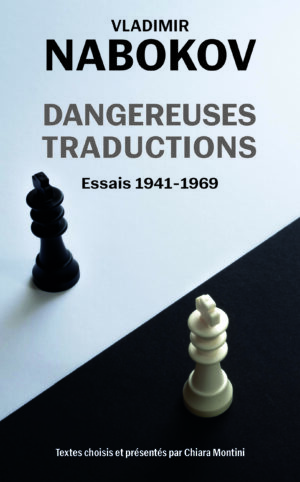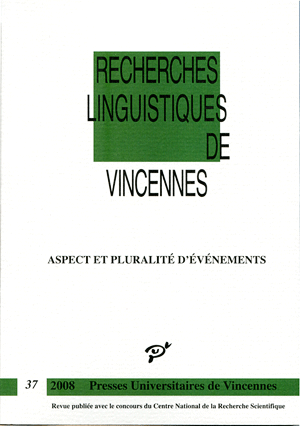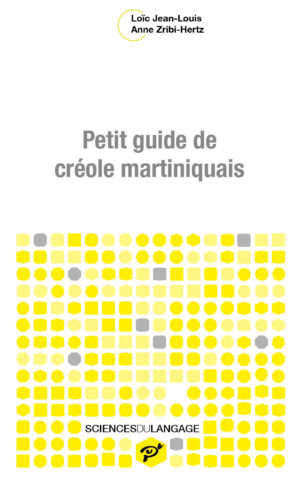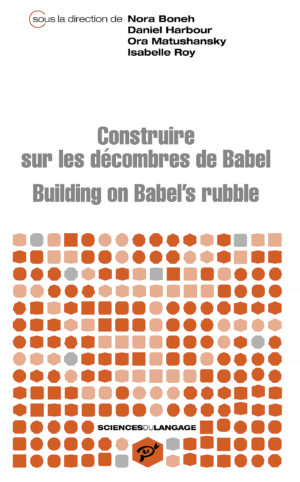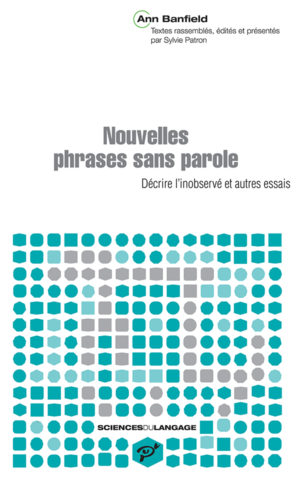Tovena Lucia M. et Kihm Alain : “Event internal pluractional verbs in some Romance languages”
This paper analyses Italian verbs such as mordicchiare and French verbs such as chantonner as pluractional verbs. Morphologically, these forms are the result of a pseudo-derivational process and cannot be cut up into two morphs, /mord/ + /ikkj/ for Italian and similarly for French, each with its own, independent contribution. The pseudo suffix is attributed submorph status, a solution that captures the fact that /ikkj/ in mordicchiare, and akin submorphs, points to two operations of semantic decomposition. One decomposition step operates at the level of the event, and signals the presence of a plurality of phases, another on a participant to the event, and captures its partial affectedness. The output of the decomposition varies depending on the lexical entry.
Bar-el Leora : “Verbal number and aspect in Skwxwú7mesh”
This paper examines two productive patterns of reduplication in Skwxwú7mesh (Squamish; Salish), exploring the relation between aspect and verbal number. The paper proposes that the CVC reduplicant, which attaches to both nouns and verbs, is a plural marker; the observed aspectual meanings (e.g., habitual, unbounded iteration) are the salient readings associated with plural events. This paper further proposes that the CV reduplicant, which attaches to verbs only, is an aspectual marker; i.e., it marks the progressive and not a plurality of sub-events. This paper adopts Lasersohn’s (1995) account of pluractionality, but proposes that the distributivity requirement is not a necessary condition for plurality in Squamish.
Fassi Fehri Abdelkader et Vinet Marie-Thérèse : “Verbal and nominal classes in Arabic and Chinese”
The paper presents a system of verbal and nominal classification based on atomic features which qualify wholes and parts of events and objects denotations. It provides a quadripartite parallel treatment of verbal and nominal classes in Arabic and Chinese, based on their mereological properties. These classes which interact with Number and Aspect are marked by Classifiers. Classifiers are construed as grammatical devices for building Individuals out of Kinds, or counting event times or event units.
Tovena Lucia M. et Donazzan Marta : “On ways of repeating”
The paper presents an analysis of event repetition as a manifestation of additivity in the ordered domain of events. A collection of iterative and aspectual adverbs belonging to different languages, such as English ‘again’, French ‘encore’ of Mandarin ‘zai’, can so receive a unified semantic analysis and be characterised as additive particles whose presupposition displays properties which are sensitive to the structural properties of the predicate, and which, in many cases, are predictable from the different syntactic positions where the adverbs occur. The content of the presupposition is computed via a conditional higher order equation. This solution makes room for two types of variation, i) in the heuristics a language may use for selecting material from the asserted clause, and ii) in the consequences of satisfying vs. accommodating a presupposition.
Boneh Nora et Doron Edit : “Deux concepts d’habitualité”
In this paper, it is proposed that natural languages express two concepts of habituality: a gnomic and an aspectual concept of regular event recurrence. The two concepts are modelled as distinct habituality operators, HabMOD and HabASP, sharing a semantic core of event recurrence over a contextually long interval. The operators differ syntactically and semantically. HabMOD is an adverb which modifies VP, whereas HabASP is an aspectual head. The paper shows first that English and Modern Hebrew grammaticalize these two concepts by two verbal forms, a periphrastic form and a simple form. Secondly, the paper shows how the proposed syntactic and semantic analysis of the operators accounts for the properties of the two habitual forms in these languages.
Doetjes Jenny : “Counting and degree modification”
This paper defends the hypothesis that number and classifiers behave differently in nominal and in verbal structures. When numerals are used in order to ‘count’ a number of objects or events, they interact differently with nouns and verbs (compare three visits with to visit three *(times)). Degree modifiers, on the other hand, behave rather similarly in the nominal and in the verbal domains (compare a lot of visits with to visit a lot). The paper discusses the source of this difference. In many languages, numerals require in many languages the presence of classifiers and/or number, while degree modifiers are sensitive to cumulative reference, a property shared by nominal and verbal structures. Given the hypothesis that nouns and verbs interact differently with number and classifiers, the different behaviour of numerals with nouns and verbs can be understood.
